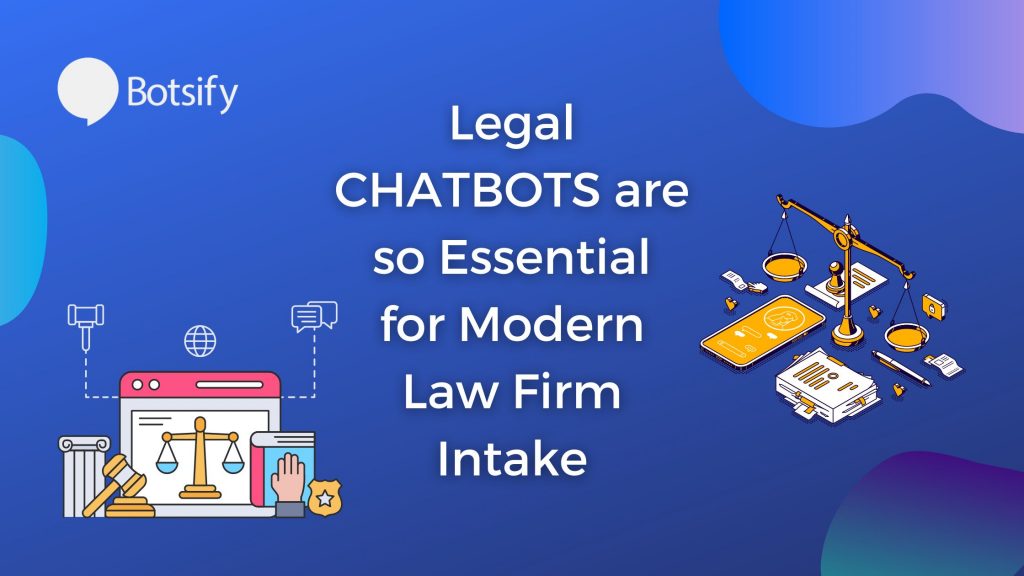You need chatbots for law firms intake because 90% of customers prefer communicating with brands, after all. There are several forms of family law firm software available, however, if you want to start experimenting with how messaging can become a part of your intake program, chatbots are a good place to start. This is in part due to the relative control you have over the system, as well as a compelling price point. Live chat, Facebook messaging, and text messaging are a few other examples.
Naturally, engagement is the main reason consumers want messaging tools (and why you want them, too). For instance, one of the critical distinctions between a chatbot and a contact form is that the former really engage the user. There is back-and-forth communication, responses, and replies. Contact forms, voicemails, and even text messages go into thin air with the possibility of receiving no reply. A chatbot responds right away and directs them to a call to action. It’s a flexible solution that also satisfies current consumer preferences, such as quick response times.
Why not exceed their expectations and respond instantly using a chatbot if, as the 2019 Clio Legal Trends Report reveals, approximately 80% of legal consumers demand a response from law firms within 24 hours of an inquiry (and 10% want a response within an hour)?
Offering a preferred channel and an interesting platform are positives from the standpoint of a lawful customer, without a doubt. Chatbots are also very helpful from the standpoint of the typical lawyer, though. Chatbots are used to screen potential clients using criteria unique to each legal firm. Chatbots screen potential customers (and boot tire kickers) for you, and save you time and money by removing the need for staff (or staff time) to answer phone calls or handle chat requests. Additionally, you may incorporate calls to action into your chatbot to encourage customers to take certain actions, such as sending leads to particular pages on your websites, sending notifications, or secretly scheduling appointments, all from a single, user-friendly interface.
Finding personal reference sources was a key component of traditional law practice marketing. Because it’s getting harder and harder to predict which channels a legal client will prefer for communication or information gathering, modern law firm marketing focuses on channel optimization. Legal Chatbot are yet another crucial weapon in your arsenal in a setting that supports omnichannel marketing. You increase your chances of landing the most lucrative cases by expanding your scope of alternatives. Additionally, chatbots are the ideal addition to any contemporary law firm marketing strategy because they are less expensive than virtual receptionists and live chat services and are more engaging than standard web-based messaging solutions.
You comprehend the importance of the legal chatbot to legal consumers and its value to law firms. You now need to construct one that truly functions in the setting of a law firm.
How to Create a Chatbot for the Highest Level of Client Engagement?
Now, hopefully, you’re working with a service provider who can assist you in developing a chatbot tailored to your area of practice. If your desired vendor has worked with enough law firms, they should have some templates available. Additionally, you will at least have a starting point if you don’t want to use what they offer.
The details of the design are crucial, therefore pay attention to the following: –
Don’t ask for the phone number right away. Customers dislike being manufactured.
Customers don’t want to be treated as a piece of marketing equipment. Don’t skip dinner and go straight in. Introduce yourself. First, let the customer explain their predicament to you or the bot. After that, gather contact information.
- Pose qualifying inquiries. What area of practice is the lead interested in specifically? Which particular aspects of a claim can the lead confirm? Does the possible lawsuit fall under your legal purview? Does the potential client want to meet with a particular lawyer or go to a particular office? Focus on the most fundamental questions.
- The purpose of this conversation is to qualify potential clients, so you should create a classification system to guide the conversation. This might not work if the lead is in Georgia and you are licensed in Alaska. What is the case’s severity? Is this a life-threatening situation? Create classifications using labels to direct leads to the proper staff member or lawyer in a timely manner.
- Even if you don’t start the conversation by asking for the contact details, you should do so at some time later on. You’ll need it after all to follow up with your lead later or to send a notification after the chat conversation. Obtain at least an email address. Your conversational structure should be succinct in the case of a homepage chatbot and should not go beyond 7–10 questions.
Obtain essential knowledge. Give your lead the option to fill in their own account of what happened. Create a call to action as the last step. Consumers gripe that attorneys fail to advise them on their next steps or what will occur. Therefore, ask your lead to set an appointment using the chatbot, or inform them that you will get in touch with them soon.
Chatbots are able to construct extensive question banks and delve deeply into branching dialogues. These use cases might even be crucial to your approach in certain circumstances. A chatbot on a particular lawyer’s page can have a distinct set of questions and be shorter than one on the homepage. A chatbot may appear and behave differently on a practice area page or at a directory profile.
Even though it may be a secondary or follow-up conversation if you ultimately opt to run your entire intake form through a chatbot, you can still use the intake features to qualify lead or client responses throughout that conversation.
Contact Botsify for chatbots for law firms anytime.

